Development by Design in Western Australia: Overcoming Offset Obstacles
Abstract
:1. Introduction
| Australian Government: Environment Protection and Biodiversity Conservation Act 1999 Environmental Offsets Policy | Western Australian Environmental Offsets Policy | Consolidated Principles Used in This Paper; Adapted from Australian and Western Australian Principles |
|---|---|---|
| 1. Suitable offsets must deliver an overall conservation outcome that improves or maintains the viability of the protected matter. | 1. Environmental offsets will only be considered after avoidance and mitigation options have been pursued. | 1. Environmental offsets may not be appropriate for all projects and will only be considered after avoidance and mitigation options have been pursued. |
| 2. Suitable offsets must be built around direct offsets but may include other compensatory measures. | 2. Environmental offsets are not appropriate for all projects. | 2. Environmental offsets will be based on sound environmental information and knowledge. |
| 3. Suitable offsets must be in proportion to the level of statutory protection that applies to the protected matter. | 3. Environmental offsets will be cost-effective, as well as relevant and proportionate to the significance of the environmental value being impacted. | 3. Establishing goals for offsets requires an estimate of expected direct and indirect impacts. |
| 4. Suitable offsets must be of a size and scale proportionate to the residual impacts on the protected matter. | 4. Environmental offsets will be based on sound environmental information and knowledge. | 4. Environmental offsets will be focused on longer term strategic outcomes. |
| 5. Suitable offsets must effectively account for and manage the risks of the offset not succeeding. | 5. Environmental offsets will be applied within a framework of adaptive management. | 5. Environmental offsets will be cost-effective, as well as relevant and proportionate to the significance of the environmental value being impacted. |
| 6. Suitable offsets must be additional to what is already required, determined by law or planning regulations, or agreed to under other schemes or programs. | 6. Environmental offsets will be focused on longer term strategic outcomes. | |
| 7. Suitable offsets must be efficient, effective, timely, transparent, scientifically robust and reasonable. | ||
| 8. Suitable offsets must have transparent governance arrangements including being able to be readily measured, monitored, audited and enforced. |
2. Study Area
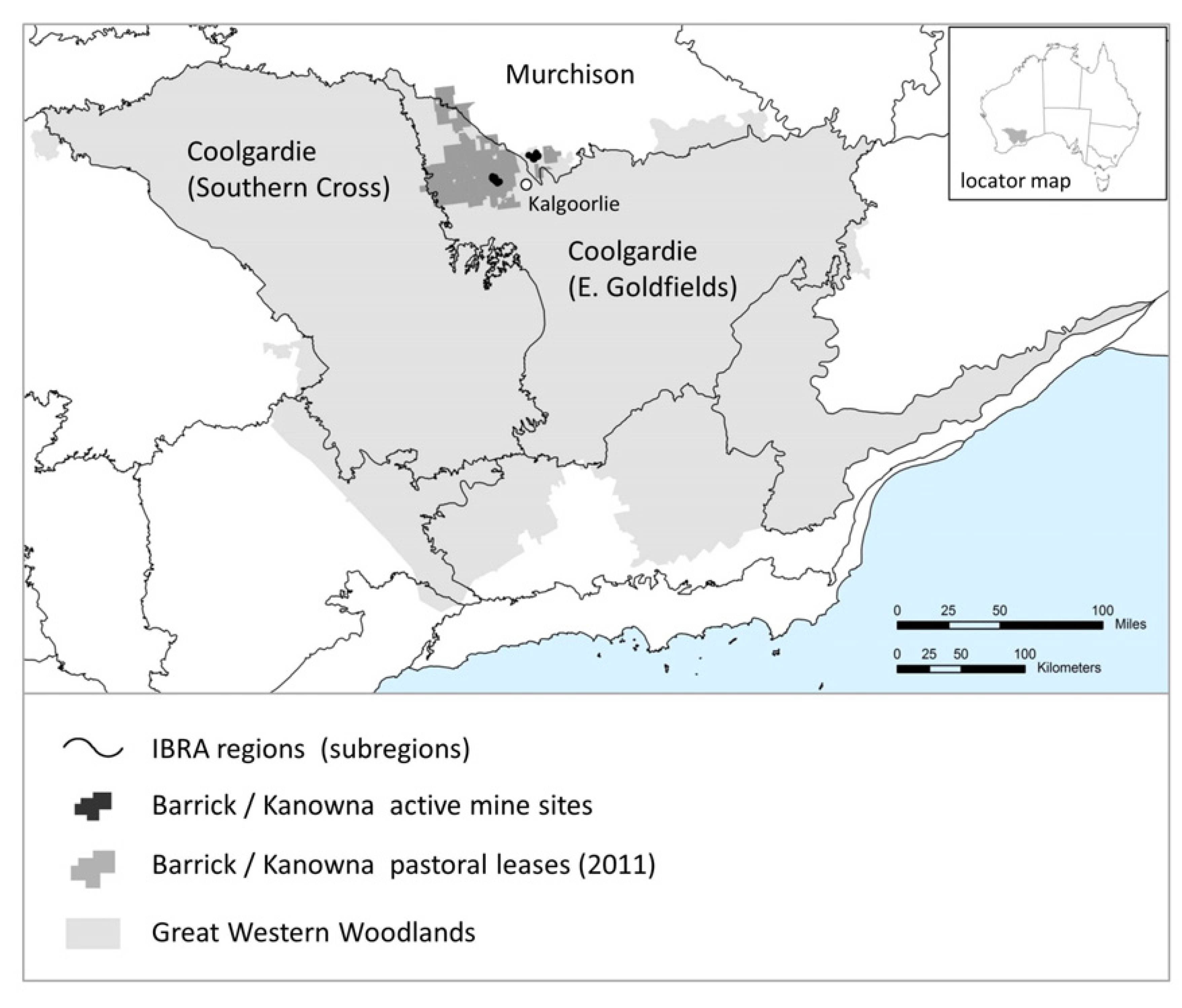
3. Applying Offset Principles to the Great Western Woodlands
3.1. Principle 1. Environmental Offsets may not be Appropriate for all Projects and will only be Considered after Avoidance and Mitigation Options Have Been Pursued
3.2. Principle 2. Environmental Offsets will be Based on Sound Environmental Information and Knowledge
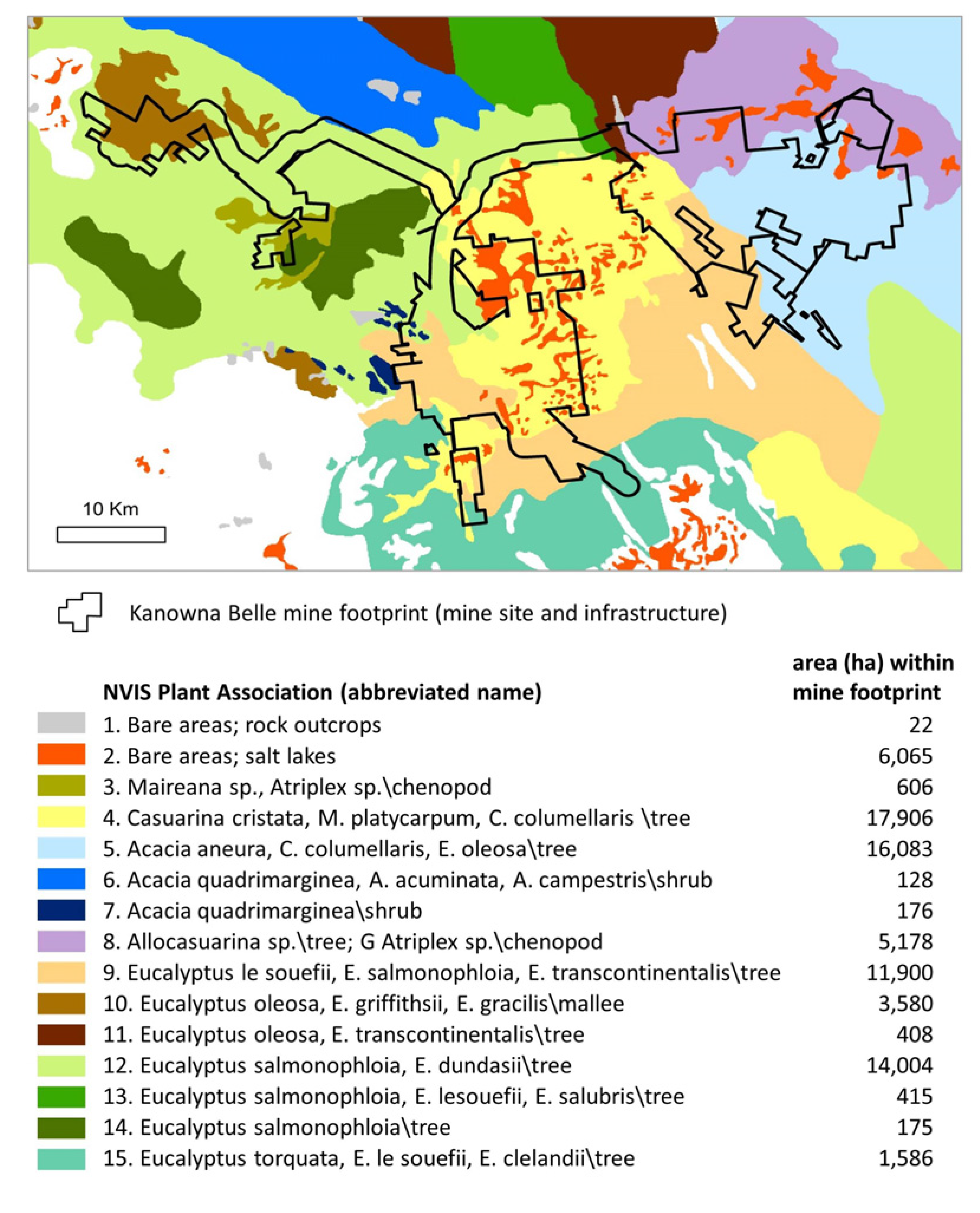
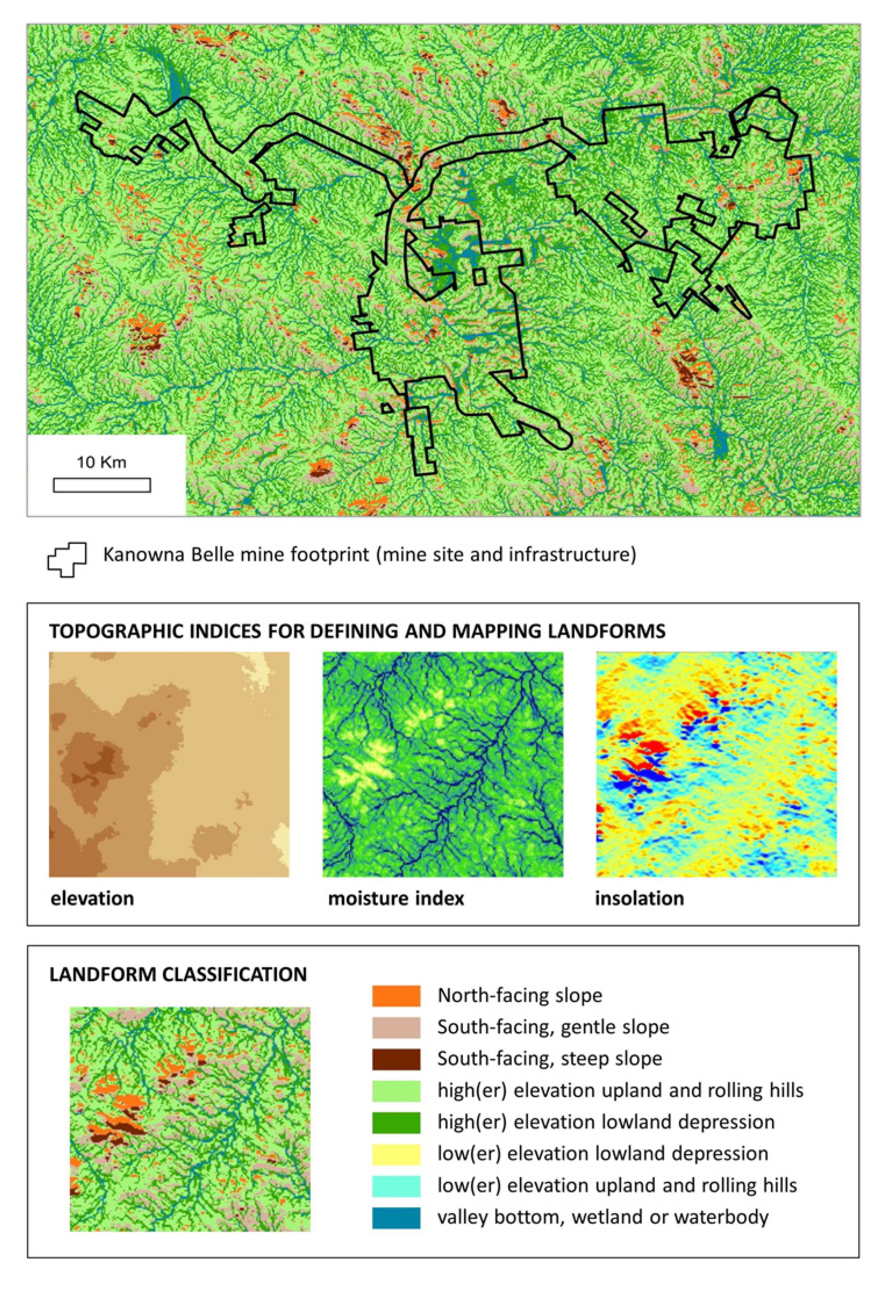
3.3. Principle 3. Establishing Goals for Offsets Requires an Estimate of Expected Direct and Indirect Impacts
| Feature | Area (ha) | Mapping Method | Source Data | |||
|---|---|---|---|---|---|---|
| Total | Tenements | |||||
| 100% Owned and Managed by Barrick | Barrick Joint Venture Managed by Barrick | Barrick Joint Venture not Managed by Barrick | ||||
| Mine Site | ||||||
| Pits & tailings | 1,294 | 1,234 | 60 | Selected features occurring within Barrick mining tenements | GEODATA TOPO 1:250 k (Geoscience Australia) | |
| 1 km buffer | 8,124 | 6,685 | 1,425 | 13 | Mapped 1 km buffer around mine site | |
| Transport | ||||||
| Connecting roads and 1 km buffer | 20,992 | 17,061 | 2,545 | 1,386 | Selected roads connecting mine sites and occurring within Barrick mining tenements, mapped 1 km buffer. | GEODATA TOPO 1:250 k (Geoscience Australia) |
| Tenement (remaining area) | 47,820 | 17,650 | 10,979 | 19,190 | Tenements classified by management | Tenement boundaries: WA Department of Mines & Petroleum; Barrick |
| Total area of impact | 78,230 | 42,630 | 15,010 | 20,589 | ||
3.4. Principle 4. Environmental Offsets will be Focused on Longer Term Strategic Outcomes
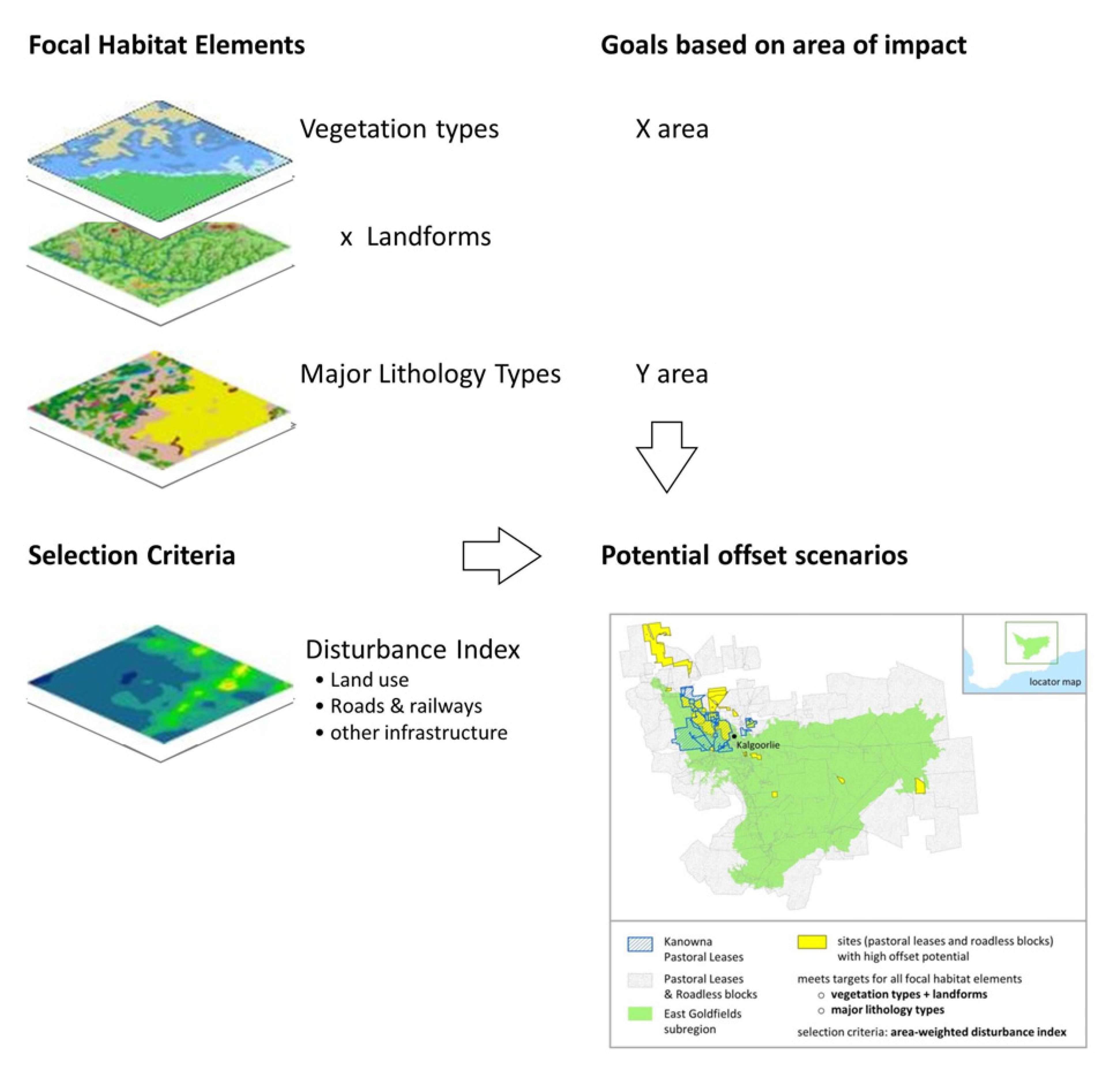
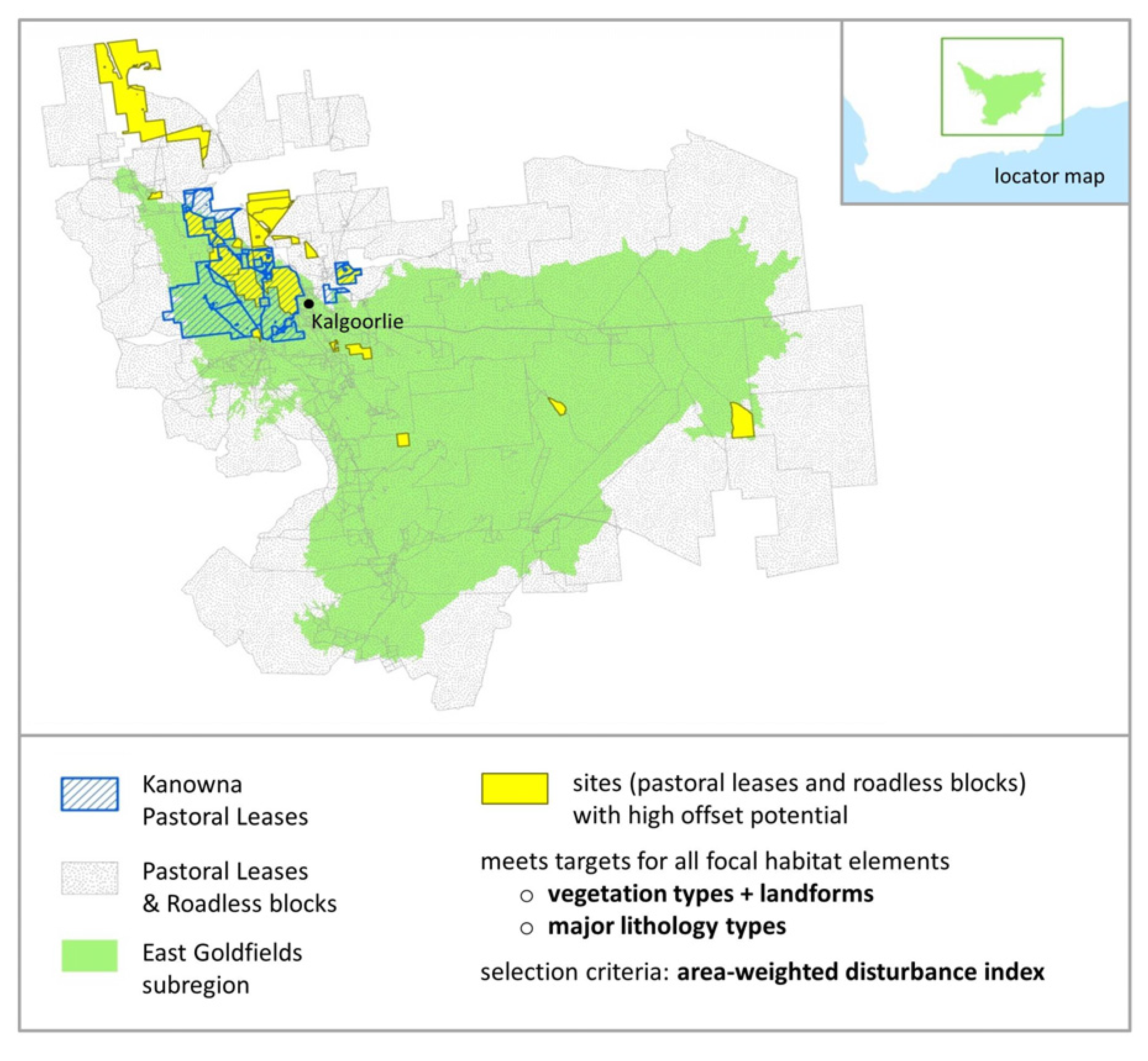
3.5. Principle 5. Environmental Offsets will be Cost-Effective, as well as Relevant and Proportionate to the Significance of the Environmental Value Being Impacted
4. Potential Offset Actions
| Actions | High 158,447 ha | Medium 142,331 ha | Old Growth Woodland 46,998 ha |
|---|---|---|---|
| Protect old growth through fire management | ● | ● | ● |
| De-stocking pastoral leases | ● | ● | ● |
| Removing artificial water sources (number*) | ● (35) | ● (64) | ● (18) |
| Road closures or track closures | ● | ● | ● |
| Recapping drill holes | ● | ● | ● |
| Control of invasive species (e.g., goats, donkeys, camels) | ● as needed | ||
| Control of invasive species (plants) | ● as needed | ||
| Non-native predator control | ● as needed | ||
| Supplementary faunal habitat | ● as needed | ||
| Active restoration (e.g., re-seeding) | ● as needed |
5. Challenges and Solutions
5.1. Limitations of Data
5.2. Legal and Institutional Barriers to Implementing Offsets
6. Conclusions
Acknowledgments
Author Contributions
Conflicts of Interest
References
- Ten Kate, K.; Bishop, J.; Bayon, R. Biodiversity Offsets: Views, Experience, and the Business Case; International Union for Conservation of Nature: Gland, Switzerland/Cambridge, UK; Insight Investment: London, UK, 2004. [Google Scholar]
- Gibbons, P.; Lindenmayer, D. Offsets for land clearing: No net loss or the tail wagging the dog? Ecol. Manage. Restor. 2007, 8, 26–31. [Google Scholar] [CrossRef]
- McKenney, B.; Kiesecker, J.M. Policy development for biodiversity offsets: A review of offset frameworks. Environ. Manage. 2010, 45, 165–176. [Google Scholar] [CrossRef]
- Council on Environmental Quality. Protection of the Environment (under the National Environmental Policy Act); Report No. 40 CFR 1500-1517; Council on Environmental Quality: Washington, DC, USA, 2000.
- New South Wales Department of Environment and Climate Change. BioBanking Biodiversity Banking and Offsets Scheme: Scheme Overview; Department of Environment and Climate Change: Sydney, NSW, Australia, 2007.
- Environmental Defense. Mitigation Banking as an Endangered Species Conservation Tool; Environmental Defense: Washington, DC, USA, 1999. [Google Scholar]
- Madsen, B.; Carrol, N.; Kandy, D.; Bennett, G. State of Biodiversity Markets Report: Offset and Compensation Programs Worldwide; Forest Trends: Washington, DC, USA, 2011. [Google Scholar]
- International Finance Corporation. Performance Standard 6. Biodiversity Conservation and Sustainable Management of Living Natural Resources; World Bank Group: Washington, DC, USA, 2012. [Google Scholar]
- Rio Tinto. Rio Tinto’s Biodiversity Strategy; Rio Tinto: London, UK/Melbourne, VIC, Australia, 2004. [Google Scholar]
- Environmental Law Institute (ELI). Mitigation of Impacts to Fish and Wildlife Habitat: Estimating Costs and Identifying Opportunities; ELI: Washington, DC, USA, 2007. [Google Scholar]
- Western Australian Government. WA Environmental Offsets Policy; Western Australian Government: Perth, WA, Australia, 2011. Available online: http://www.epa.wa.gov.au/EPADocLib/WAEnvOffsetsPolicy-270911.pdf (accessed on 1 July 2013).
- Department of Sustainability, Environment, Water, Population and Communities (DSEWPC). Environment Protection and Biodiversity Conservation Act 1999 Environmental Offsets Policy; DSEWPC: Canberra, ACT, Australia, 2012.
- Golden Ridge Limited. BBOP Pilot Project Case Study. Akyem Gold Mining Project, Eastern Region, Ghana; Newmont Golden Ridge Limited: Accra, Ghana, 2009. Available online: www.forest-trends.org/biodiversityoffsetprogram/guidelines/newmont-casestudy.pdf (accessed on 1 July 2013).
- Barrick. Building Value in Everything We Do: Annual Report 2010; Barrick: Toronto, ON, Canada, 2010. [Google Scholar]
- Barrick. Available online: http://barrickresponsibility.com/2009/en/environment/biodiversity.html (accessed on 7 July 2013).
- Kiesecker, J.M.; Copeland, H.; Pocewicz, A.; Nibbelink, N.; McKenney, B.; Dahlke, J.; Holloran, M.; Stroud, D. A framework for implementing biodiversity offsets: selecting sites and determining scale. BioScience 2009, 59, 77–84. [Google Scholar] [CrossRef]
- Norton, D. Biodiversity offsets: two New Zealand case studies and an assessment framework. Environ. Manage. 2009, 43, 698–706. [Google Scholar] [CrossRef]
- Moilanen, A.; van Teefelen, A.J.A.; Ben-Haim, Y.; Ferrier, S. How much compensation is enough? A framework for incorporating uncertainty and time discounting when calculating offset ratios for impacted habitat. Restor. Ecol. 2009, 17, 470–478. [Google Scholar] [CrossRef]
- Treweek, J.; Butcher, B.; Temple, H. Biodiversity offsets: Possible methods for measuring biodiversity losses and gains for use in the UK. Practice 2010, 69, 29–32. [Google Scholar]
- Quetier, F.; Lavorel, S. Assessing ecological equivalence in biodiversity offset schemes: Key issues and solutions. Biol. Conserv. 2012, 144, 2991–2999. [Google Scholar] [CrossRef]
- Kiesecker, J.; Heiner, M.; Sochi, K.; McKenney, B.; Fitzsimons, J. Development by Design: Cooperative Mitigation Planning for Barrick Gold’s Kanowna Belle Operations in Western Australia; The Nature Conservancy: Fort Collins, CO, USA, 2013. Available online: http://www.nature.org/ourinitiatives/urgentissues/smart-development/australia-project-update -smart-development.pdf (accessed on 13 October 2013).
- Watson, A.; Judd, S.; Watson, J.; Lam, A.; Mackenzie, D. The Extraordinary Nature of the Great Western Woodlands; The Wilderness Society of WA Inc: Perth, WA, Australia, 2008. [Google Scholar]
- Australian Government. Available online: http://www.environment.gov.au/parks/nrs/science/bioregion-framework/ibra/index.html (accessed on 25 July 2012).
- Kiesecker, J.M.; Copeland, H.; Pocewicz, A.; McKenney, B. Development by design: Blending landscape level planning with the mitigation hierarchy. Front. Ecol. Environ. 2010, 8, 261–266. [Google Scholar] [CrossRef]
- Kiesecker, J.M.; Sochi, K.; Heiner, M.; McKenney, B.; Evans, J.; Copeland, H. Development by Design: Using a Revisionist History to Guide a Sustainable Future. In Encyclopedia of Biodiversity, 2nd ed.; Levin, S.A., Ed.; Academic Press: Waltham, MA, USA, 2013; pp. 495–507. [Google Scholar]
- Kiesecker, J.M.; Copeland, H.; McKenney, B.; Pocewicz, A.; Doherty, K. Energy by Design: Making Mitigation Work for Conservation and Development. In Energy Development and Wildlife Conservation in Western North America; Naugle, D.E., Ed.; Island Press: Washington, DC, USA, 2011; pp. 159–181. [Google Scholar]
- Environment Protection Authority. Gold Roaster to Treat Refractory Ore, Kanowna Belle Mine, Stage 2, 18 km North East of Kalgoorlie; Bulletin 710; Environment Protection Authority: Perth, WA, Australia, 1993.
- Clare, S.; Krogman, N.; Foote, L.; Lemphers, N. Where is the avoidance in the implementation of wetland law and policy? Wetlands Ecol. Manage. 2011, 19, 165–182. [Google Scholar] [CrossRef]
- Pilgrim, J.D.; Brownlie, S.; Ekstrom, J.M.M.; Gardner, T.A.; von Hase, A.; Ten Kate, K.; Savy, C.E.; Stephens, R.T.T.; Temple, H.J.; Treweek, J.; et al. A process for assessing the offsetability of biodiversity impacts. Conserv. Lett. 2013, 6, 376–384. [Google Scholar]
- Pressey, R.L.; Bottrill, M.C. Opportunism, threats, and the evolution of systematic conservation planning. Conserv. Biol. 2008, 22, 1340–1345. [Google Scholar] [CrossRef]
- Copeland, H.E.; Doherty, K.E.; Naugle, D.E.; Pocewicz, A.; Kiesecker, J.M. Mapping oil and gas development potential in the US Intermountain West and estimating impacts to species. PLoS ONE 2009, 4, e7400. [Google Scholar]
- Thorne, J.H.; Huber, P.R.; Girvetz, E.H.; Quinn, J.; McCoy, M.C. Integration of regional mitigation assessment and conservation planning. Ecol. Soc. 2009, 14, 47–63. [Google Scholar]
- Saenz, S.; Walschburger, T.; León, J.; Gonzalez, J. Manual Para Asignación de Compensaciones por Pérdida de Biodiversidad; Convenio de Asociación No.09 de 2008; Ministerio de Ambiente, Vivienda y Desarrollo Territorial/The Nature Conservancy/World Wildlife Fund/Conservación Internacional: Bogota, Colombia, 2010. [Google Scholar]
- Heiner, M.; Galbadrakh, D.; Kiesecker, J.M.; McKenney, B.; Evans, J.; Enkhtsetseg, T.; Dash, Z.; Vanchindorj, U.; Baast, O.; Dolgorjav, S.; et al. Identifying Conservation Priorities in the Face of Future Development: Applying Development by Design in the Grasslands of Mongolia; The Nature Conservancy: Fort Collins, CO, USA, 2011. [Google Scholar]
- Executive Steering Committee for Australian Vegetation Information. Australian Vegetation Attribute Manual: National Vegetation Information System, Version 6.0; Department of the Environment and Heritage: Canberra, ACT, Australia, 2003.
- Stewart, A.J.; Sweet, I.P.; Needham, R.S.; Raymond, O.L.; Whitaker, A.J.; Liu, S.F.; Phillips, D.; Retter, A.J.; Connolly, D.P.; Stewart, G. Surface Geology of Australia 1:1,000,000 Scale, Western Australia (Digital Dataset); Geoscience Australia: Canberra, ACT, Australia, 2008. [Google Scholar]
- Beard, J.S.; Webb, M.J. The Vegetation Survey of Western Australia: Its Aims, Objects and Methods. In Vegetation Survey of Western Australia. Part 1 of Explanatory Notes to Sheet 2—Great Sandy Desert; University of Western Australia Press: Perth, WA, Australia, 1974. [Google Scholar]
- Rich, P.M.; Hetrick, W.A.; Saving, S.C. Modeling Topographic Influences on Solar Radiation: A Manual for the SOLARFLUX Model, LA-12989-M; Los Alamos National Laboratories: Los Alamos, NM, USA, 1995. [Google Scholar]
- Moore, I.D.; Grayson, R.B.; Ladson, A.R. Digital terrain modelling: A review of hydrological, geomorphological, and biological applications. Hydrol. Process. 1991, 5, 3–30. [Google Scholar]
- Morton, S.R.; James, C.D. The diversity and abundance of lizards in arid Australia: A new hypothesis. Amer. Nat. 1988, 132, 237–256. [Google Scholar]
- Hebblewhite, M. A Literature Review of the Effects of Energy Development on Ungulates: Implications for Central and Eastern Montana; Report prepared for Montana Fish, Wildlife and Parks: Miles, MT, USA, 2008. [Google Scholar]
- Maron, M.; Dunn, P.K.; McAlpine, C.A.; Apan, A. Can offsets really compensate for habitat removal? The case of the endangered red-tailed black-cockatoo. J. Appl. Ecol. 2010, 47, 348–355. [Google Scholar] [CrossRef]
- Groves, C.; Jensen, D.; Valutis, L.; Redford, K.; Shaffer, M.; Scott, J.; Baumgartner, J.; Higgins, J.; Beck, M.; Anderson, M. Planning for biodiversity conservation: Putting conservation science into practice. BioScience 2002, 52, 499–512. [Google Scholar] [CrossRef]
- Groves, C. Drafting a Conservation Blueprint: A Practitioner’s Guide to Planning for Biodiversity; Island Press: Washington, DC, USA, 2003. [Google Scholar]
- Higgins, J.; Esselman, R. Ecolregional Assessment and Biodiversity Toolbox. 2006. Available online: http://www.conservationgateway.org/Files/Pages/ecoregional-assessment-to.aspx (accessed on 31 January 2012).
- Margules, C.R.; Pressey, R.L. Systematic conservation planning. Nature 2000, 405, 243–53. [Google Scholar] [CrossRef]
- Forman, R.T.T.; Sperling, D.; Bissonette, J.A.; Clevenger, A.P.; Cutshall, C.D.; Dale, V.H.; Fahrig, L.; France, R.L.; Goldman, C.R.; Heanue, K.; et al. Road Ecology: Science and Solutions; Island Press: Washington, DC, USA, 2002. [Google Scholar]
- Fletcher, R.J.; Robertson, B.A.; Evans, J.; Doran, P.J.; Alavalapati, J.R.; Schemske, D.W. Biodiversity conservation in the era of biofuels: Risks and opportunities. Front. Ecol. Environ. 2011, 9, 161–168. [Google Scholar] [CrossRef]
- Johnson, C.J.; Boyce, M.S.; Case, R.L.; Cluff, H.D.; Gau, R.J.; Gunn, A.; Mulders, R. Cumulative effects of human developments on Arctic wildlife. Wildl. Monogr. 2005, 160, 1–36. [Google Scholar]
- Vors, L.S.; Schaefer, J.A.; Pond, B.A.; Rodgers, A.R.; Patterson, B.R. Woodland caribou extirpation and anthropogenic landscape disturbance in Ontario. J. Wildl. Manage. 2007, 71, 1249–1256. [Google Scholar] [CrossRef]
- Ball, I.R.; Possingham, H.P. MARXAN (V1.8.2): Marine Reserve Design Using Spatially Explicit Annealing—A Manual. 2000. Available online: http://www.uq.edu.au/marxan/docs/marxan_manual_1_8_2.pdf (accessed on 25 July 2012).
- Possingham, H.P.; Ball, I.R.; Andelman, S. Mathematical Methods for Identifying Representative Reserve Networks. In Quantitative Methods for Conservation Biology; Ferson, S., Burgman, M., Eds.; Springer-Verlag: New York, NY, USA, 2000; pp. 291–305. [Google Scholar]
- Burgin, S. BioBanking: An environmental scientist’s view of the role of biodiversity banking offsets in conservation. Biodivers. Conserv. 2008, 17, 807–816. [Google Scholar] [CrossRef]
- Fox, J.; Nino Murcia, A. Status of species conservation banking in the United States. Conserv. Biol. 2005, 19, 996–1007. [Google Scholar] [CrossRef]
- Daniel, G. Bushfire Threat Analysis of the Great Western Woodlands; Department of Environment and Conservation: Perth, WA, Australia, 2010.
- O’Donell, A.J.; Boer, M.M.; McCaw, W.L.; Grierson, P.F. Vegetation and landscape connectivity control wildfire intervals in unmanaged semi-arid shrublands and woodlands in Australia. J. Biogeog. 2010, 38, 112–124. [Google Scholar]
- Fitzsimons, J.A.; Peake, P.; Frood, D.; Mitchell, M.; Withers, N.; White, M.; Webster, R. Flooding requirements for biodiversity values along the Victorian floodplain of the Murray Valley. Victorian Nat. 2011, 128, 48–85. [Google Scholar]
- Jones, H.; Salmon, D. Unintended Consequences and Mine Closure. In Mine Closure 2012: Proceedings of the International Mine Closure 2012 Congress, Brisbane, Australia; Fourie, A.B., Tibbett, M., Eds.; Australian Centre for Geomechanics: Perth, WA, Australia, 2012; pp. 703–716. [Google Scholar]
- Department of Regional Development and Lands (DRDL). Rangelands Tenure Options Discussion Paper April 2011; DRDL: Perth, WA, Australia, 2011.
- Niewand, G.; Fitzsimons, J. Earth Resources Activities on Crown Land: Guidelines and Procedures for Land Managers; Department of Sustainability and Environment: Melbourne, VIC, Australia, 2005.
- Adams, V.M.; Moon, K. Security and equity of conservation covenants: Contradictions of private protected area policies in Australia. Land Use Policy 2013, 30, 114–119. [Google Scholar] [CrossRef]
- US Bureau of Land Management. Record of Decision for the Jonah Infill Drilling Project Environmental Impact Statement; Department of the Interior, Bureau of Land Management Pinedale Field Office: Pinedale, WY, USA, 2006.
- Morris, R.K.A.; Alonso, I.; Jefferson, R.G.; Kirby, K.J. The creation of compensatory habitat—Can it secure sustainable development? J. Nature Conserv. 2006, 14, 106–116. [Google Scholar] [CrossRef]
- Maron, M.; Hobbs, R.; Moilanen, A.; Matthews, J.W.; Christie, K.; Gardner, T.A.; Keith, D.A.; Lindenmayer, D.B.; McAlpine, C.A. Are restoration offsets Faustian bargains? Restoration realities in the context of biodiversity offset policies. Biol. Conserv. 2012, 155, 141–148. [Google Scholar] [CrossRef]
- Walker, S.; Brower, A.L.; Stephens, R.T.; Lee, W.G. Why bartering biodiversity fails. Conserv. Lett. 2009, 2, 149–157. [Google Scholar] [CrossRef]
© 2014 by the authors; licensee MDPI, Basel, Switzerland. This article is an open access article distributed under the terms and conditions of the Creative Commons Attribution license (http://creativecommons.org/licenses/by/3.0/).
Share and Cite
Fitzsimons, J.; Heiner, M.; McKenney, B.; Sochi, K.; Kiesecker, J. Development by Design in Western Australia: Overcoming Offset Obstacles. Land 2014, 3, 167-187. https://doi.org/10.3390/land3010167
Fitzsimons J, Heiner M, McKenney B, Sochi K, Kiesecker J. Development by Design in Western Australia: Overcoming Offset Obstacles. Land. 2014; 3(1):167-187. https://doi.org/10.3390/land3010167
Chicago/Turabian StyleFitzsimons, James, Michael Heiner, Bruce McKenney, Kei Sochi, and Joseph Kiesecker. 2014. "Development by Design in Western Australia: Overcoming Offset Obstacles" Land 3, no. 1: 167-187. https://doi.org/10.3390/land3010167
APA StyleFitzsimons, J., Heiner, M., McKenney, B., Sochi, K., & Kiesecker, J. (2014). Development by Design in Western Australia: Overcoming Offset Obstacles. Land, 3(1), 167-187. https://doi.org/10.3390/land3010167






